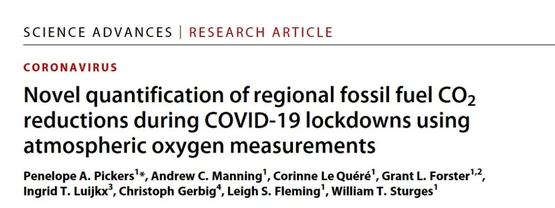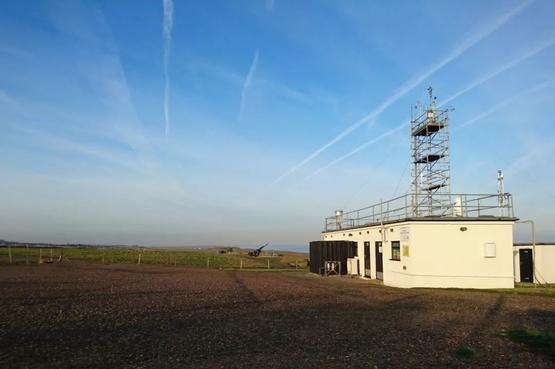Recently, a team from the University of East Anglia has made a major breakthrough in detecting the speed and frequency of changes in carbon dioxide emissions from fossil fuels.
Using atmospheric measurements of carbon dioxide and oxygen from the Webern Atmospheric Observatory on the north Norfolk coast in the UK, the researchers quantified localised carbon dioxide emissions reductions from fossil fuels during the COVID-19 lockdown.
They used a new method to separate carbon dioxide signals from land plants and fossil fuels in the atmosphere . Until now, it has not been possible to quantify local-area-scale changes in fossil fuel CO2 emissions with high accuracy and near real-time.
Existing atmosphere-based methods have largely failed to separate carbon dioxide from fossil fuels from the bulk of natural carbon dioxide changes, so estimating changes, such as those due to pandemic lockdowns, must Relying on indirect data sources, which can take months or years of work.
The method, based on atmospheric oxygen, published in the journal Science Advances, fits well with three less frequent emissions estimates made during the pandemic by the UK Department for Business, Energy and Industrial Strategy, the Global Carbon Budget and Carbon Monitor. . But the three departments use different methods, such as energy consumption calculations in some departments; the newly developed method is not only completely independent of other estimation methods, but also faster.

Screenshot of the paper
In addition, the researchers were able to detect changes in emissions with greater frequency, such as daily estimates, and were able to clearly observe that the two emission reduction cycles coincided exactly with the UK’s two lockdown periods, with 2020 in between. This summer, the carbon emissions recovery period after the easing of the Covid-19 lockdown.
The University of East Anglia (UEA) is the UK’s only laboratory for high-precision atmospheric oxygen measurements, and researchers at the Institute collaborate with Wageningen University in the Netherlands and Max Planck for Biogeochemical Research (Germany). colleagues at the Max Planck Institute for Biogeochemistry, Germany).
Lead author of the study, Dr Penelope Pixar, from the Centre for Ocean and Atmospheric Sciences at the University of East Anglia, said: “If humans are to reduce carbon dioxide emissions from fossil fuels and the impact of human behaviour on the climate, we first need to know that carbon Changes in emissions. Our study is a major achievement in atmospheric science. Other studies were based solely on carbon dioxide data and failed because large amounts of gas emitted by terrestrial plants obscured the fossil fuel carbon dioxide signal in the atmosphere. The separation of atmospheric oxygen and carbon dioxide from fossil fuel carbon dioxide in the atmosphere allows us to detect and quantify these important signals using a ‘top-down’ approach for the first time. Our results show that a network of continuous measurement sites has a large potential to provide assessments of fossil fuel carbon dioxide at the regional level.”
Currently, official reporting of CO2 emissions from fossil fuels follows a ” bottom-up ” approach, using an accounting method that combines emission factors with energy statistics to calculate emissions. These data are then compiled into a national greenhouse gas emissions inventory, which estimates anthropogenic sources and various activity factors in the atmosphere, such as greenhouse gas emissions from homes, vehicles, and industrial processes.
However, the data in the inventory may be inaccurate, especially in less developed countries—making it difficult to achieve climate goals; not to mention that inventory assessments can take years to complete; and on a local scale, Measured assessments conducted on a monthly or weekly basis are also much more uncertain.

Weybourne Weather Observatory | Grant Foster
Another way to estimate greenhouse gas emissions is to use a ” top-down ” approach based on atmospheric measurements and modeling. The UK’s inventory of greenhouse gas emissions has achieved initial success with an independent top-down assessment of key greenhouse gases such as methane and nitrous oxide. But there have been no previous success stories for carbon dioxide, the most important greenhouse gas responsible for climate change, making it difficult to distinguish between carbon dioxide emissions from the burning of fossil fuels in the atmosphere and respiration by land plants and where those emissions come from.
Dr Pixar said: “Calculating carbon emissions over historical periods takes time, and current methods make it difficult for us to describe changes in emissions over a short period of time, such as those associated with social shutdowns during Covid-19. We need reliable Fossil fuel CO2 emissions estimation methods so that we can monitor and inform climate change policy and prevent global warming from reaching 2 °C. Our O2 -based approach reduces costs and increases the frequency of information, potentially in a better space Quickly provide estimates of fossil fuel carbon dioxide at scales, such as within a county, state or city.”
The research team used the Webern Atmospheric Observatory’s 10-year high – precision, hourly measurement of O and CO in the atmosphere, with support from the UK’s National Center for Atmospheric Science. Long-term measurements of these key climate gases are critical.
To detect gas signatures during Covid-19, they first had to use a machine learning model to remove the effects of atmospheric transport on their oxygen and carbon dioxide datasets.
The researchers tuned a machine-learning model to simulate the fossil fuel carbon dioxide values observed at Webern under a pandemic situation, based on pre-COVID-19 data. They then compared this estimate with the actual observed fossil fuel CO2 over the 2020-2021 period, and ultimately found that CO2 emissions decreased by comparison.
references
[1] https://ift.tt/daHqwXn
[2] https://ift.tt/o5xzaFt
Compilation: Oasis
Edit: Crispy Fish
Typesetting: Yin Ningliu
Title image source: Pixabay
Paper information
Published the journal Science Advances
Posted on April 22, 2022
Paper title Novel quantification of regional fossil fuel CO2 reductions during COVID-19 lockdowns using atmospheric oxygen measurements
(DOI: https://ift.tt/URvkLJB)
Article Field Atmospheric Science
research team
First Author/Corresponding Author Penelope A. Pickers: PhD, Research Fellow, Centre for Ocean and Atmospheric Sciences, School of Environmental Sciences, University of East Anglia
Homepage of the research group https://ift.tt/ASaUtmj
The Future Light Cone Accelerator is an early-stage technology entrepreneurship accelerator initiated by Nutshell Technology. It provides proposals for scientists in different stages of entrepreneurship, ranging from company registration, intellectual property rights, to financing needs, and team formation. Accelerate the transformation of scientific and technological achievements from the laboratory to the market, and accelerate the iteration of some scientists to become CEOs.
The Nutshell team has 12 years of experience in serving scientists. We always make suggestions from the perspective of scientists and be good friends of science and technology creators. If you are planning to start a technology business, whether you are looking for money, people, resources, or orders, you are welcome to chat with the Future Light Cone team. You can send bp or other project information to [email protected] , and leave your contact information, or add the Wechat of Guoke Hard Technology Enterprise to communicate by private message.

✦
✦
Click to read the original text to view the original paper
This article is reproduced from: http://www.guokr.com/article/461495/
This site is for inclusion only, and the copyright belongs to the original author.